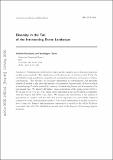| dc.contributor.author | Rosenhaus, Vladimir | |
| dc.contributor.author | Taylor, Washington | |
| dc.date.accessioned | 2014-08-07T13:22:25Z | |
| dc.date.available | 2014-08-07T13:22:25Z | |
| dc.date.issued | 2009-06 | |
| dc.date.submitted | 2009-05 | |
| dc.identifier.issn | 1029-8479 | |
| dc.identifier.issn | 1126-6708 | |
| dc.identifier.uri | http://hdl.handle.net/1721.1/88564 | |
| dc.description.abstract | Techniques are developed for exploring the complete space of intersecting brane models on an orientifold. The classification of all solutions for the widely-studied T[superscript 6]/Z[subscript 2] × Z[subscript 2] orientifold is made possible by computing all combinations of branes with negative tadpole contributions. This provides the necessary information to systematically and efficiently identify all models in this class with specific characteristics. In particular, all ways in which a desired group G can be realized by a system of intersecting branes can be enumerated in polynomial time. We identify all distinct brane realizations of the gauge groups SU(3) × SU(2) and SU(3) × SU(2) × U(1) which can be embedded in any model which is compatible with the tadpole and SUSY constraints. We compute the distribution of the number of generations of ''quarks'' and find that 3 is neither suppressed nor particularly enhanced compared to other odd generation numbers. The overall distribution of models is found to have a long tail. Despite disproportionate suppression of models in the tail by K-theory constraints, the tail of the distribution contains much of the diversity of low-energy physics structure. | en_US |
| dc.description.sponsorship | United States. Dept. of Energy (Contract DE-FC02-94ER40818) | en_US |
| dc.description.sponsorship | National Science Foundation (U.S.) (Grant PHY05-51164) | en_US |
| dc.language.iso | en_US | |
| dc.publisher | Springer-Verlag | en_US |
| dc.relation.isversionof | http://dx.doi.org/10.1088/1126-6708/2009/06/073 | en_US |
| dc.rights | Creative Commons Attribution-Noncommercial-Share Alike | en_US |
| dc.rights.uri | http://creativecommons.org/licenses/by-nc-sa/4.0/ | en_US |
| dc.source | arXiv | en_US |
| dc.title | Diversity in the tail of the intersecting brane landscape | en_US |
| dc.type | Article | en_US |
| dc.identifier.citation | Rosenhaus, Vladimir, and Washington Taylor. “Diversity in the Tail of the Intersecting Brane Landscape.” Journal of High Energy Physics 2009, no. 06 (June 1, 2009): 073–073. | en_US |
| dc.contributor.department | Massachusetts Institute of Technology. Center for Theoretical Physics | en_US |
| dc.contributor.department | Massachusetts Institute of Technology. Department of Physics | en_US |
| dc.contributor.mitauthor | Rosenhaus, Vladimir | en_US |
| dc.contributor.mitauthor | Taylor, Washington | en_US |
| dc.relation.journal | Journal of High Energy Physics | en_US |
| dc.eprint.version | Original manuscript | en_US |
| dc.type.uri | http://purl.org/eprint/type/JournalArticle | en_US |
| eprint.status | http://purl.org/eprint/status/NonPeerReviewed | en_US |
| dspace.orderedauthors | Rosenhaus, Vladimir; Taylor, Washington | en_US |
| dc.identifier.orcid | https://orcid.org/0000-0001-8566-6706 | |
| mit.license | OPEN_ACCESS_POLICY | en_US |
| mit.metadata.status | Complete | |
